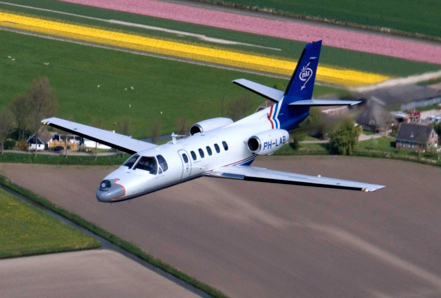The Requirement

Photo : Royal NLR
The Royal Netherlands Aerospace Centre (Royal NLR) is an aerospace research organization of the Netherlands and is one of its major technology institutes, operating a Cessna Citation II special mission testbed. This Citation II research aircraft offers opportunities to perform a wide variety of flight test applications. Extensive modifications have turned this pressurized, twin-engine business jet into a versatile airborne research platform.
Flight test mission sets include aerodynamics, flight mechanics, zero-gravity, atmosphere, airborne remote sensing and flight test methods, to system tests, air traffic management, avionics, alternative fuels and flight inspection.
Obsolete flight deck avionics no longer adequately supported the missions operated for clients and sponsors.
Why the Operator Selected MC2
The operator became aware that MC2 had past performance with very similar modifications for a fleet of Citation II aircraft operated by the Canadian government. Those modifications had EASA Supplemental Type approval providing a clear and risk-free certification path for any changes needed for an additional airframe.
Main Benefits

Photo : Royal NLR
A modern digital integrated flight deck avionics system now allows testing of new experimental display formats inflight and supports flight operations in the rapidly-changing Eurocontrol airspace environment. Safety and situational awareness were greatly enhanced. The Pro Line 21 Integrated Display System (IDS) enhances situational awareness at every phase of flight with three large 10 x 8-inch liquid crystal displays (LCDs). The Primary Flight Display (PFD) combines attitude, altitude, air speed and heading references with an easy-to-read graphical interface. The system’s multifunction display (MFD) enables pilots to quickly reference information to permit strategic decision-making.
About the Mods
The existing suite of avionics were removed with the exception of the Radar Altimeter, Flight Directors and Autopilot systems. Two modern VHF Communication radios, two VHF Navigation/Automatic Direction Finder receivers and two new DME transceivers were installed. New Audio Panels were installed at each pilot’s side panel. A new glareshield was installed in accordance with an existing Supplemental Type Certificate (STC) to house a relocated annunciator panel and other annunciators and switches. Two Radio Tuning Units were installed in the center and right flight instrument panels. New instrument panels were fabricated to house the new IDS and all other required instrumentation and annunciation/switching. A three-display suite of Collins Pro Line 21 IDS was installed.
A single Universal Avionics EGNOS-capable Flight Management System was installed with an LP/LPV Monitor and a Multifunction Control Display Unit (MCDU).
A Universal Class A Terrain Awareness and Warning System (TAWS) was installed and interfaced to existing and new systems to provide the crew with aural and visual terrain warnings as well as display of relative terrain position.
Two Collins Mode S Transponders were installed along with a Collins Traffic Alert and Collision Avoidance System (TCAS) Processor and antennas.
A second Reduced Vertical Separation Minimum (RVSM)-compliant Air Data Computer was installed.
The existing Directional Gyro components and Vertical Gyro Systems were removed and replaced by two modern Collins Attitude and Heading Reference Systems (AHRS).
Interfaces were provided from the new avionics suite to the mission systems.
